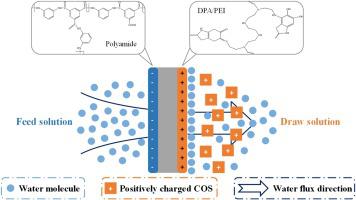Journal of Water Process Engineering ( IF 7 ) Pub Date : 2020-06-24 , DOI: 10.1016/j.jwpe.2020.101439 Xiang-Yu Chi , Ming-Xiao Zhang , Zhen-Liang Xu , Bao-Gen Xia

|
In this study, a flat-sheet polyamide thin film composite (TFC) membrane with different surface charges has been designed as a forward osmosis (FO) membrane while a positively-charged organic chitooligosaccharide (COS) applied as a draw solution (DS). The flat-sheet TFC FO membrane consists of three layers (from top to bottom): the polyamide selective layer, electrospun cellulose triacetate (CTA) nanofibers and mechanically robust polyacrylonitrile (PAN) nanofibers coated with dopamine (DPA)/polyethyleneimine (PEI). The DPA/PEI modification on the PAN nanofibers has proven to be efficient and resulted in a more positively-charged surface with improved hydrophilicity. Meanwhile, the polyamide layer formed by the interfacial polymerization (IP) method was negatively charged on top of the FO membrane. The interaction between surface-charged membranes and positively-charged draw solutes in the FO process has been investigated comprehensively. The result showed that hydrophilicity and electrostatic repulsion could alleviate the fouling generated by organic DS, while hydrophobicity and electrostatic attraction could magnify the fouling. Finally, the positively-charged DS was recycled by the positively-charged PEI NF membranes with a reasonably high special water flux and salt rejections. Therefore, this study shows that the combination of the surface-charged membranes and positively-charged COS DS has the desirable water flux, little reverse salt flux (RSF) and fouling effects. In conclusion, the developed membrane is providing a new way to design practical FO processes.
中文翻译:

正向渗透过程中表面带电膜与带正电荷的汲取溶质之间相互作用的新见解
在这项研究中,具有不同表面电荷的平板聚酰胺薄膜复合(TFC)膜已被设计为正渗透(FO)膜,而带正电荷的有机壳寡糖(COS)被用作汲取溶液(DS)。平板TFC FO膜由三层组成(从上到下):聚酰胺选择层,静电纺丝三乙酸纤维素(CTA)纳米纤维和涂有多巴胺(DPA)/聚乙烯亚胺(PEI)的机械坚固的聚丙烯腈(PAN)纳米纤维。PAN纳米纤维上的DPA / PEI改性已被证明是有效的,并且可以使表面带更多正电荷,并且具有改善的亲水性。同时,通过界面聚合(IP)方法形成的聚酰胺层在FO膜的顶部带负电。全面研究了FO过程中表面带电膜与带正电荷的溶质之间的相互作用。结果表明,亲水性和静电排斥作用可以减轻有机DS产生的污垢,而疏水性和静电吸引作用可以放大污垢。最后,带正电的DS被带正电的PEI NF膜回收,并具有相当高的特殊水通量和脱盐率。因此,这项研究表明,带表面电荷的膜和带正电荷的COS DS的组合具有理想的水通量,极小的反盐通量(RSF)和结垢效果。总之,开发的膜为设计实际FO工艺提供了一种新方法。



























 京公网安备 11010802027423号
京公网安备 11010802027423号